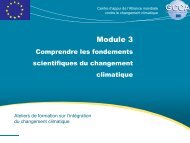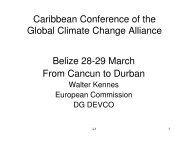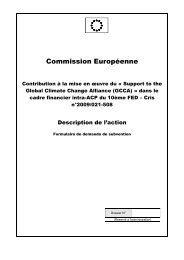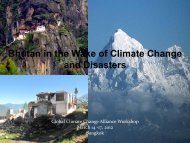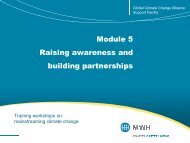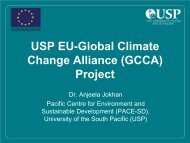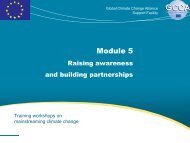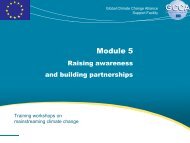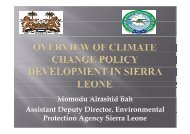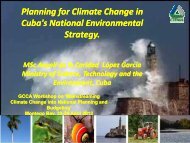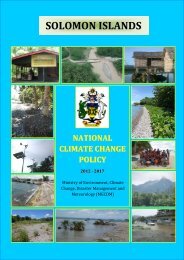Rwanda Green Growth Strategy 18nov11 - Global Climate Change ...
Rwanda Green Growth Strategy 18nov11 - Global Climate Change ...
Rwanda Green Growth Strategy 18nov11 - Global Climate Change ...
You also want an ePaper? Increase the reach of your titles
YUMPU automatically turns print PDFs into web optimized ePapers that Google loves.
Chapter 2The Kigali City Master Plan and <strong>Rwanda</strong>’s rural settlement and land consolidation policies addressthis to some degree but unless secondary urban areas are developed to a level where they can sustainindependent economic growth, there is a danger of Kigali becoming a sprawling megacity. Withoutintervention, Kigali could expand to 5,000km 2 , nearly 20% of <strong>Rwanda</strong>’s land area, putting serious pressureon food production.The development of slums could result in health problems and increase the incidence of crime.<strong>Rwanda</strong> therefore needs to carefully plan the growth of its urban areas to ensure that they are sustainable.The transition from a rural to an urban economy will require new skills, technology, and infrastructure. Jobcreation will be crucial and education will be necessary to build the skilled workforce to fill those jobs.Population growth, together with climate change and oil price spikes, could seriously hinder development in<strong>Rwanda</strong> and the achievement of Vision 2020 goals.Chapter 2: <strong>Rwanda</strong>’s Development Pathway2.3 Future DevelopmentVision 2020 seeks to transform <strong>Rwanda</strong> from a subsistence agriculture economy to a knowledgebasedsociety, with high levels of savings and private investment, and thereby reduce the country’sdependence on external aid. There are a number of key targets in Vision 2020, notably the aim of reachingmiddle income status (900 USD per capita) by 2020. The Economic Development and Poverty Reduction<strong>Strategy</strong> (EDPRS) 2008 to 2012 is the framework for achieving Vision 2020 and the MillenniumDevelopment Goals (MDGs). There are three flagship programmes that prioritise public spending andimprove sector coordination: Sustainable <strong>Growth</strong> for Jobs and Exports, Vision 2020 Umurenge Programme(social protection) and Good Governance.Business as UsualWhen discussing climate change, a country’s planned economic growth path is termed Business asUsual (BAU) and it refers to projected GHG emissions without intervention. <strong>Rwanda</strong> has one of the lowestGHG emissions per capita in the world, estimated at 0.6 tCO2e/person compared to a global average of6.7 tCO2e/person, including land use change, in 2005 [4] . GHG emissions have shown an upward trend,from 2,896Gg in 2003 to 5,793Gg in 2006 and are likely to continue to rise. <strong>Rwanda</strong>’s GHG emissionsbaseline was set in 2005 in preparation for the Second National Communication (SNC) to the UNFCCC,amounting to 5,010Gg. The aggregate GHG emissions or total CO2 equivalent (used for measuring globalwarming potential) were dominated by agriculture while four key sources contribute 91% of aggregateemissions (Figure 10a): N2O from agricultural soils (57%), CH4 from enteric fermentation in domesticlivestock (19%), CH4 from residential energy from fuel combustion (8%) and CO2 from road vehicles (5%).CO2 emissions were dominated by transport and industrial processes (Figure 10b) though CO2sequestration made <strong>Rwanda</strong> a net carbon sink. There are uncertainties in the GHG inventory due toinadequate representation, lack of basic data and application of emissions factors for different conditions.Owing to the rapid development in energy and industry in <strong>Rwanda</strong>, these figures need to be revisited toaccount for uncertainties in growth projections, energy intensity and the energy supply mix.National <strong>Strategy</strong> on <strong>Climate</strong> <strong>Change</strong> and Low Carbon Development 11




